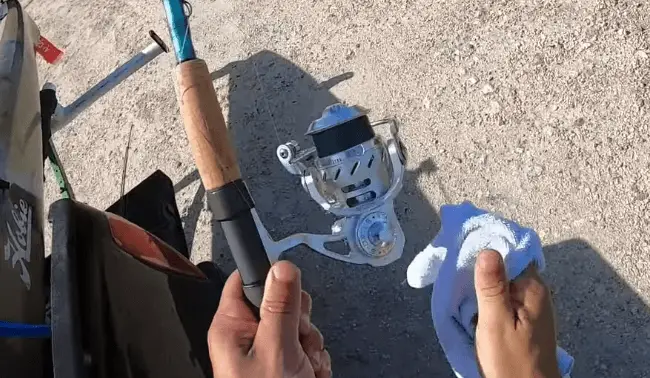Clean Saltwater Reels
To clean saltwater reels, rinse them thoroughly with fresh water and wipe them down with a clean cloth. Proper maintenance is essential for longevity and performance of your fishing equipment.
Saltwater reels are exposed to corrosive salt, sand, and debris which can accumulate and damage the reel if not cleaned regularly. By following simple cleaning steps after each use, you can ensure smooth operation and extend the lifespan of your reels.
Regular cleaning will also help prevent rust and corrosion, keeping your equipment in top condition for your next fishing adventure. It is crucial to invest time in maintaining your saltwater reels to maximize their performance and durability.
Tools For Clean Saltwater Reels
To properly clean your saltwater reels, you will need to gather the necessary tools. Having the right equipment on hand will make the cleaning process efficient and effective.
Basic Tools
1. Screwdriver
2. Clean rags
3. Soft-bristled brush
4. Toothbrush
Specialized Cleaning Products
- Reel lubricant2.
- Reel cleaner solution
- Corrosion inhibitor spray
- Fine-grit sandpaper
Preparation For Clean Saltwater Reels
Preparation is key when it comes to properly cleaning your saltwater reels. Before diving into the cleaning process, it’s important to get everything organized and set up for an efficient and effective cleaning session. By following the steps below, you can ensure that you have everything you need and are ready to tackle the cleaning process with confidence.
Organizing Work Area
Before starting the cleaning process, organize your work area to ensure a smooth and hassle-free experience. Gather all the necessary cleaning supplies, such as a soft cloth, mild soap, fresh water, and any specific reel cleaning products that you may have. Also, ensure that you have a clean and spacious area to work in, with ample lighting to clearly see the details of your saltwater reels. Keeping your work area organized and free of clutter will make the cleaning process more efficient and enjoyable.
Removing Line And Handle
Start by removing the line and handle from your saltwater reel. This step is crucial to thoroughly clean the reel and ensure that all components are properly maintained. Use a reel spool remover tool if necessary to safely detach the line, and carefully unscrew the handle from the reel body. Keep track of any screws or small components that you remove to avoid misplacing them during the cleaning process. By removing the line and handle, you will have better access to the inner mechanisms of the reel, allowing for a more thorough cleaning.
Saltwater Reels Cleaning Process
To clean saltwater reels, start by rinsing with fresh water, then disassemble and clean each part thoroughly. Use a mild detergent solution and a soft brush to remove salt residue. After cleaning, ensure all components are completely dry before reassembling the reel to prevent corrosion and maintain performance.
Cleaning The Exterior
The first step in cleaning your saltwater reel is to focus on the exterior. Start by wiping down the reel with a soft cloth to remove any dirt or grime. Pay close attention to the handle, bail arm, and drag knob, as these areas tend to accumulate the most debris.
- Use a small brush or old toothbrush to gently scrub these areas, being careful not to apply too much pressure.
- Rinse the reel with freshwater to remove any remaining dirt.
- Dry the reel thoroughly with a clean cloth to prevent any water spots or corrosion.
Disassembling The Reel Components
Once the exterior of your saltwater reel is clean, it’s time to move on to disassembling the internal components. This step requires some extra care and attention, so make sure you have a clean workspace and keep track of each part as you remove it. Follow these steps to disassemble your saltwater reel:
Gather Your Tools
Before you start disassembling the reel, gather the necessary tools to make the process smoother:
- Screwdrivers (varying sizes)
- Needle-nose pliers
- A clean, well-lit workspace
Follow the Manufacturer’s Manual
Consult your reel’s manufacturer’s manual for specific instructions on disassembling your reel model. While the overall process may be similar for most reels, each model may have its unique specifications. The manual will guide you step-by-step through the process, ensuring you disassemble the reel correctly.
Clean Each Component
As you disassemble the reel components, make sure to clean each one individually. Use a soft brush or cloth to remove any dirt or salt residue. Pay attention to the gears, spool, and bearings, as these areas are particularly prone to salt build-up.
Inspect for Damage
While cleaning each component, take the opportunity to inspect for any signs of damage or wear. Look for any cracks, rust, or excessive wear on the gears and bearings. If you notice any issues, it’s best to replace the damaged parts before reassembling the reel.
Reassemble the Reel
After cleaning and inspecting each component, it’s time to reassemble the reel. Use the manufacturer’s manual as a guide to ensure each piece is correctly aligned and attached. Take your time during this step to avoid any mishaps or mistakes that could affect the reel’s performance.
In conclusion, cleaning your saltwater reel involves carefully cleaning the exterior and disassembling the reel components. By following the manufacturer’s manual and paying attention to each part, you can ensure your reel is clean and in good working condition. Regular maintenance and cleaning will extend the lifespan of your reel and improve your overall fishing experience.
Deep Cleaning Techniques
Saltwater reels require deep cleaning techniques to remove accumulated salt, grime, and debris. Follow these steps to ensure your reels stay in optimal condition, providing smooth and efficient fishing experiences.
Regular maintenance and cleaning of saltwater reels are essential to keep them functioning smoothly and prolong their lifespan. While basic cleaning can remove dirt and debris, deep cleaning techniques are necessary to tackle saltwater corrosion and grime build-up. In this section, we will explore two effective deep cleaning techniques: soaking parts in cleaner and using a soft bristle brush.
Soaking Parts In Cleaner
Soaking the individual parts of your saltwater reel in a specialized cleaner is a highly effective deep cleaning technique. It allows the cleaner to penetrate stuck-on grime, salt, and other contaminants, resulting in a thorough clean. Here’s how to do it:
1. Begin by disassembling your saltwater reel carefully. Take note of the position and order of each part for easy reassembly later.
2. Fill a container with a sufficient amount of reel cleaner. Make sure to choose a cleaner specifically designed for saltwater reels.
3. Place the disassembled parts of the reel into the container, ensuring that each part is fully submerged in the cleaner. 4. Let the parts soak for the recommended amount of time specified by the manufacturer. This is typically around 15-30 minutes.
5. While the parts are soaking, you can take this opportunity to clean the reel’s exterior and handle using a mild soap and water solution.
6. After the soaking period has passed, carefully remove each part from the cleaner, ensuring they are free from any remaining residue or grime.
7. Rinse each part thoroughly with clean water to remove any traces of the cleaner.
8. Place the rinsed parts on a clean towel or cloth to air dry completely before reassembling the reel. Using this deep cleaning technique on a regular basis will help maintain the performance and longevity of your saltwater reel.
Using A Soft Bristle Brush
In addition to soaking the parts, using a soft bristle brush is another effective technique for deep cleaning your saltwater reel. This method allows you to target hard-to-reach areas and remove stubborn debris. Follow these steps to ensure a thorough clean:
1. First, disassemble your saltwater reel carefully, referring to the manufacturer’s instructions or diagrams if needed.
2. Inspect each part and identify areas where dirt and grime have accumulated.
3. Dip the soft bristle brush into a mixture of mild soap and water.
4. Gently scrub the dirty areas of each part, using small circular motions. Pay close attention to crevices, gears, and other hard-to-reach spots.
5. Avoid using excessive force that could potentially damage the parts. Remember, gentle and steady cleaning is key.
6. Rinse the parts thoroughly with clean water to remove any soapy residue or debris.
7. Place the rinsed parts on a towel or cloth and allow them to air dry completely.
8. Once dry, carefully reassemble the saltwater reel according to the manufacturer’s instructions. By incorporating this soft bristle brush technique into your maintenance routine, you can effectively remove stubborn saltwater residue and ensure the longevity of your reel.
Remember, regular and thorough deep cleaning of your saltwater reel is crucial for optimal performance and longevity. By incorporating these deep cleaning techniques into your maintenance routine, you’ll be able to enjoy many successful fishing trips with a well-maintained reel.
Drying And Reassembly
Saltwater reels require specific care to maintain their performance, and proper drying and reassembly are crucial steps in the maintenance process. It’s essential to ensure that all components are thoroughly dried to prevent corrosion and damage. Once the drying is completed, reassembling the reel correctly will guarantee its smooth operation and longevity. Let’s explore the steps for drying and reassembling saltwater reels in detail.
Drying The Reel Components
After cleaning the saltwater reel components, thorough drying is crucial to prevent rust and corrosion. Remove all excess moisture by wiping each part with a dry cloth. Pay special attention to the small crevices and corners where water may be trapped. To expedite the drying process, use a hairdryer set to a cool, gentle setting to ensure that no heat damage occurs. Leave the components in a well-ventilated area for an extended period to allow any remaining moisture to evaporate completely.
FAQ
How Do You Clean Saltwater Reels?
First, rinse the reel with fresh water to remove loose salt and debris. Then, use a soft brush or toothbrush to gently scrub the reel, focusing on the exterior, handle, and bail. Use a mild soap or reel cleaner to remove stubborn dirt.
Rinse thoroughly and dry with a microfiber cloth. Finally, apply a small amount of reel lubricant to ensure smooth operation.
Can You Use Saltwater Reels In Freshwater?
Although saltwater reels are designed for harsh saltwater conditions, they can also be used in freshwater. However, it is important to thoroughly clean the reel after each use in saltwater to avoid salt buildup, which can damage the reel. Regular maintenance will help keep your saltwater reels suitable for both freshwater and saltwater fishing reel.
Last Word
Regular maintenance of your saltwater reels is essential for their longevity and optimal performance. By following these cleaning steps, you can ensure that your reels remain in top condition and continue to provide smooth and reliable operation. With proper care, you can extend the life of your saltwater reels and enjoy successful fishing trips for years to come.


